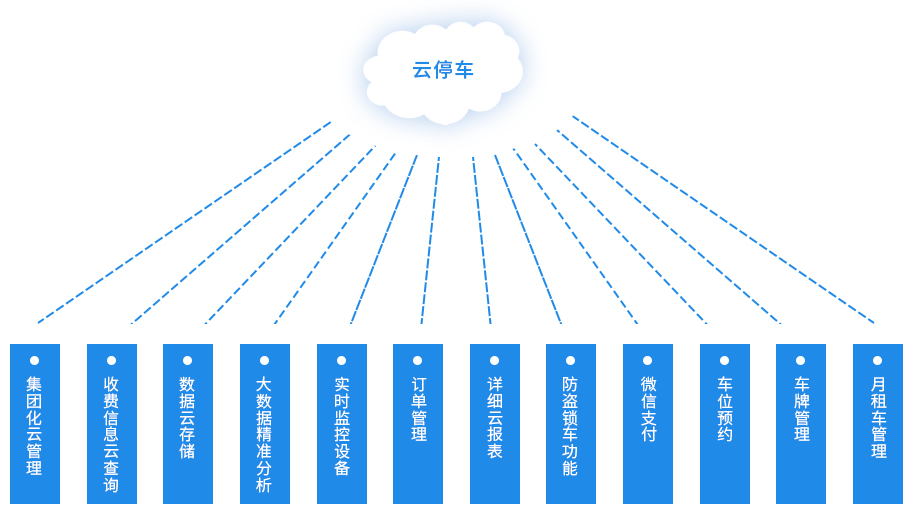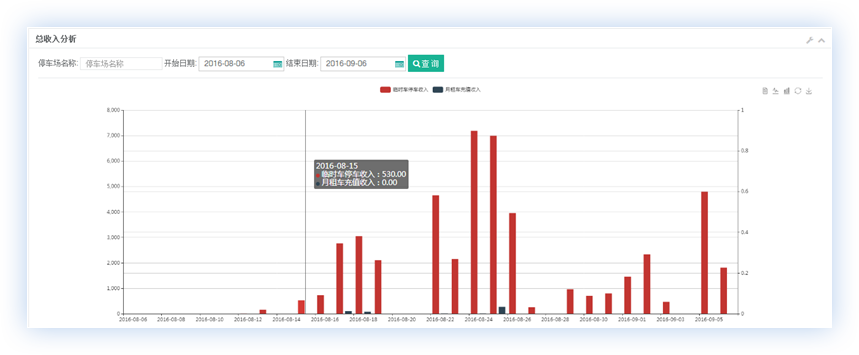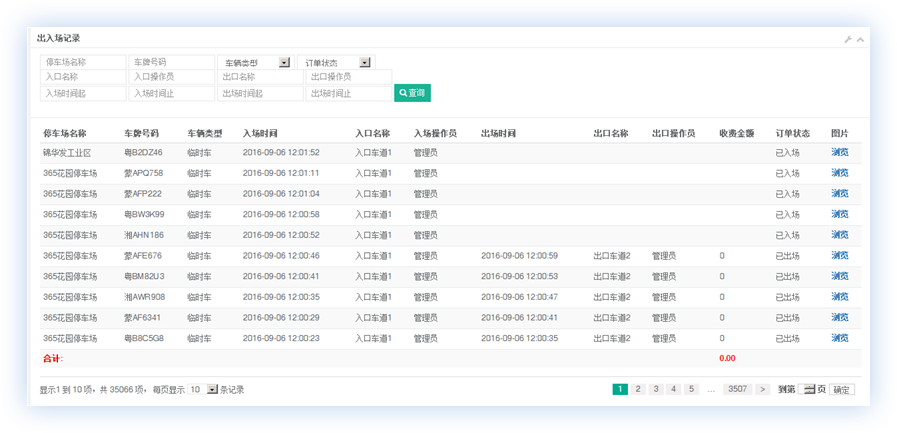Contact Info
- Building 2, Dongguang Industrial Park, Dongxihu District, Wuhan City, Hubei Province
- +86 (027) 6538 2096
- +86 153 2729 1193
- +86 (027) 6538 2096
- service@fuyingshijie.com
Product Catalog
Cloud parking
Introduction to Cloud Park
1. The enterprise version of the Internet parking lot management platform (referred to as the cloud parking lot) is an application platform that combines the Internet with the parking lot. Using 3G/4G network, the Internet, and the Internet of Things to aggregate the relevant information of each parking lot under the jurisdiction of the group, breaking through regional restrictions, the administrator can view the payment details, traffic flow and seat usage of each parking lot on the platform;
2. Install the enterprise version of the Internet parking management platform to query various reports in real time, check the charging status of the day, the charging status of the month, and whether there are illegal gate openings and free car entry and exit records. Realize cloud storage of parking lot data, cloud management of vehicle information, and cloud statistics of financial data. Through the two-way transmission, aggregation and analysis of data, the cloud parking lot can remotely manage all its parking lots anytime and anywhere, and master comprehensive data and the latest developments;
3. The cloud parking APP service function has been added to provide a mobile phone software with convenient, accurate and reliable parking services for drivers, which can realize parking space inquiry of surrounding parking lots, mobile payment of parking fees, finding parking spaces in the parking lot, anti-theft car lock, anti-theft parking To find a car and other functions.


Cloud parking lot advantages
1. The cloud parking lot uses advanced technology to establish an advanced parking information system. Through big data management, scientifically organize urban traffic, improve the level of urban parking management, improve the utilization rate of parking lots, improve parking efficiency, and solve the problem of urban parking difficulties;
2. The web client does not need to install any software, just open the browser on the Internet, you can log in to the Internet parking lot management platform to manage the parking lot, and you can also log in to the management platform through mobile phones, tablets and other networked devices;
3. Summarize and analyze various financial statements, grasp financial data in real time, and eliminate financial loopholes. Cloud parking can manage multiple parking lots through cloud computing, and make use of idle parking lots;
4. Real-time remote monitoring of equipment operation status, effectively reducing maintenance costs. Flexible configuration can easily respond to customer needs and completely change your business model.

System Architecture

1. Unified core components
Internet parking lot management platform (cloud parking lot), multiple license plate recognition intelligent parking lot management system, mobile phone terminal, self-service payment terminal (optional)
2. Platform principle description
The offline parking lot sends data to the Internet platform through middleware technology. The user uses the computer, mobile phone WeChat or app to query the parking data in the platform. After the user pays the fee, the platform uses the middleware technology to push the payment information to the parking lot. When the parking user drives out, the parking software determines whether the vehicle has paid the fee, and if the fee has been paid, the gate will be automatically opened.
System Features

1. System management
Parking lot permissions, administrator permissions, permissions group permissions.
2. Parking lot order management
Order maintenance, entry and exit records, abnormal release records.
3. Monthly rental management
Monthly rental information, recharge, vehicle, user, cancellation details, etc.
4. Parking lot status
The parking space, equipment status, etc. of each parking lot.
5. Report management
Remaining parking spaces, traffic flow, temporary car/monthly rental, income analysis, financial reconciliation, payment information, etc.
6. Mobile APP management
Parking reservation, anti-theft car lock, parking navigation, WeChat payment, recharge extension, coupons, etc.

Total revenue query and analysis


Parking space and traffic flow analysis


Entry and exit record query

Real-time monitoring of device status

Platform payment flow

Platform scope

Preliminary preparation
1. WeChat account preparation
1) Application process
● Apply for WeChat public account (service account)
● Official account WeChat certification
● WeChat payment application
2) Parameters provided
● To open a cloud parking account, you need to provide: WeChat official account and password, and WeChat merchant account and password (for engineers to configure related menus and interface connection)
● Self-service payment terminals need to provide: AppID and AppSecret
2. Cloud server preparation
1) The configuration of the cloud server is determined according to the number of parking lots, the number of parking lots in and out, and whether the picture function is required. Flexible configuration according to the requirements of your own parking lot, it is recommended to use the relatively stable Alibaba Cloud, etc., and after the purchase is completed, the cloud server should be recorded.
2) According to the full function, 1000 times of entry and exit per day, 10 parking lots, the minimum configuration is as follows:
● Specifications: 4 cores above 8G
● Mirror: windows Server2008R2 64-bit, Chinese Enterprise Edition or above
● Hard disk: 500G
● Network bandwidth: at least 2-3M
3. Domain name preparation
1) Purpose: Used to configure WeChat sites and platform sites (WeChat service callbacks only support domain name access)
2) Matters needing attention: apply for a domain name and record the domain name
Cloud Depot Deployment
1. Online platform - cloud platform settings
The engineer sets the relevant parameters of the platform, and enters the payment account number and other information into the background
2. Offline platform - parking lot deployment
1) High-definition license plate recognition software cloud parking lot version installation
2) Cloud depot middleware client installation
3) Necessary installation of middleware system
